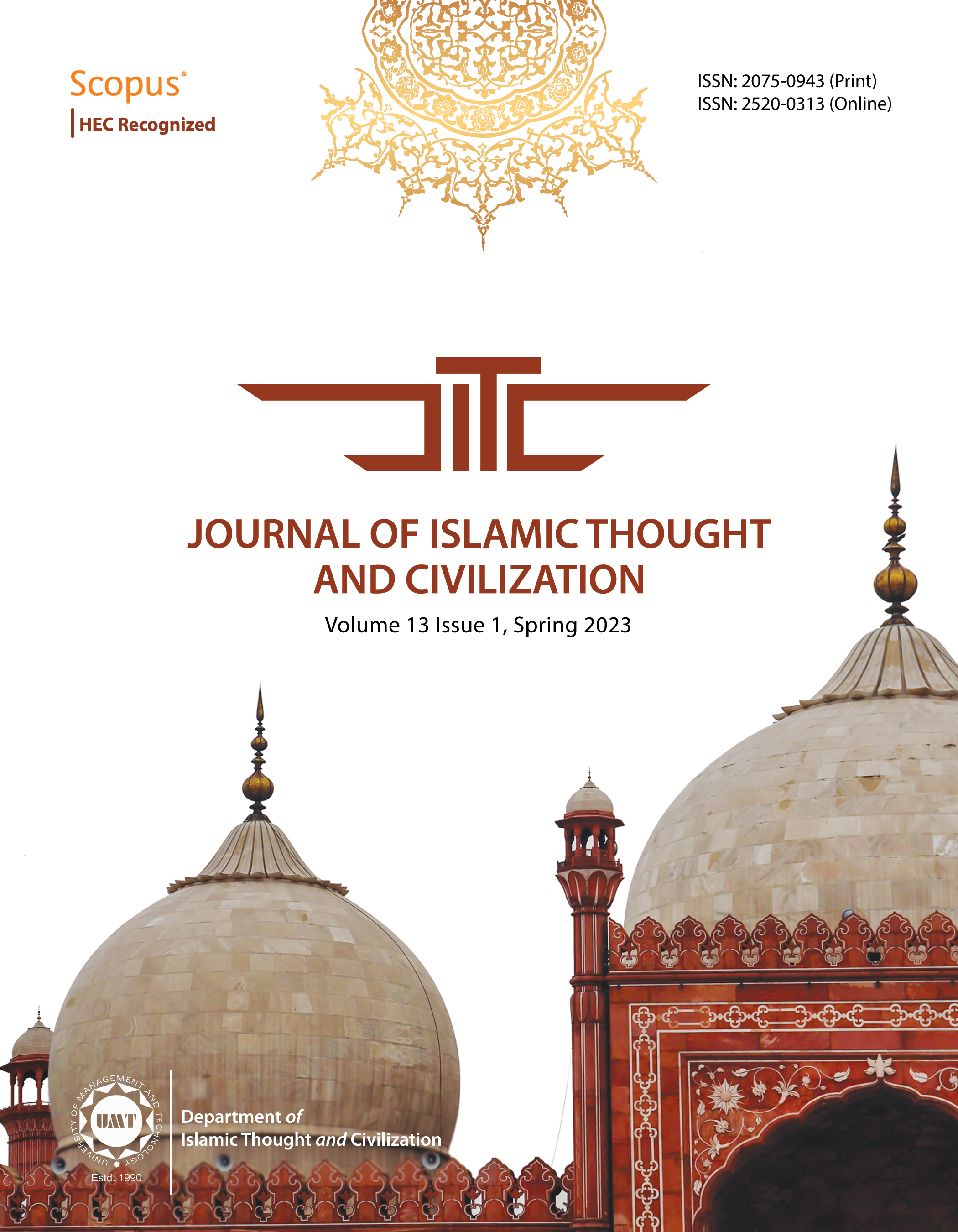ISIS’ Miscontextualization of Ḥadīth through the Strategic Linguistic Propaganda: A Socio-political Analysis
Abstract
 Abstract Views: 61
Abstract Views: 61
ISIS has used language propaganda to further its sociopolitical objectives and defend its harsh behavior through the miscontextualization of ḥadīth. This study uses linguistic stylistics to demonstrate the language used in ISIS's magazine “Dabīq,” which made piecemeal usage of ḥadīth (Prophet Muhammad's sayings) to justify its actions. To do so, the study first thematizes the ḥadīths that ISIS reported. It then points out the silences (by “silences,” we mean important ḥadīths that are missing from ISIS’s discourse) involved in ISIS's discourse concerning these themes, in which the critical ḥadīths are absent from ISIS's discourse as they emphasize lessons and teachings other than those that ISIS propagates. The results revealed that ISIS used two ḥadīths to celebrate its role in what they consider the revival of the Khilāfah, four ḥadīths to portray itself as the Jihādist organization that most imitates Imamah, two ḥadīths to reinforce violent Jihād as the spearhead of its Minhāj (way or path), and one ḥadīth to call for Hijrah in its territories. The study revealed ISIS's preference for particular themes in ḥadīth over others; thus, the study gives voice to those ḥadīths that are absent from ISIS's discourse, where the ḥadīths directly related to the thematic areas involved in ISIS's speech are unavailable.
Downloads
References
Abdi, Reza., and Ali Basarati. “A Critical Analysis of the Representation of the Yemen Crisis in Ideologically-Loaded Newspaper Headlines.” GEMA Online Journal of Language Studies 16:3 (2016): 37-52. https://pdfs.semanticscholar.org/df38/8587f6f97a46c6cb21e0243 DOI: https://doi.org/10.17576/gema-2016-1603-03
Abumelhim, Mohammad Husni., Ramzy Mahmoud Radaideh, and Esra’a Omar Abu-Alkeshek. “Sociology of Terrorism: A Brief History and Overview of the Islamic State of Iraq and Syria’s (ISIS) Propaganda Wing from a Socio-Educational Perspective.” Journal of Educational and Social Research 12 (2) (2022) :399. https://doi.org/10.36941/jesr-2022-0061. DOI: https://doi.org/10.36941/jesr-2022-0061
Akhmetova, Elmira. “Islam and Politics in Malaysia since 1957. Journal of Islamic Thought and Civilization 9.2 (2019): 01-19. DOI: https://doi.org/10.32350/jitc.92.01
Azami, Muhammad Mustafa. Studies in Ḥadīth Methodology and Literature. American Trust Publications, 1978.
Bisgin, Halil., Ḥasan Arslan, and Yusuf Korkmaz. “Analyzing the Dabīq Magazine: The Language and the Propaganda Structure of ISIS.” In International Conference on Social Computing, Behavioral-Cultural Modeling and Prediction and Behavior Representation in Modeling and Simulation, 1–11 Springer, Cham, 2019. https://doi.org/10.1007/978-3-030-21741-9_1 DOI: https://doi.org/10.1007/978-3-030-21741-9_1
Boutz, Jennifer., Hannah Benninger, and Alia Lancaster. “Exploiting the Prophet's Authority: How Islamic State Propaganda uses Ḥadīth Quotation to Assert Legitimacy.” Studies in Conflict and Terrorism 42.11 (2019): 972-996. https://doi.org/10.1080/1057610X.2018.1431363 DOI: https://doi.org/10.1080/1057610X.2018.1431363
Council on American-Islamic Relations (CAIR). (2014, Sep. 24). CAIR: U.S., World Muslim Leaders' Open Letter Refutes ISIS's Ideology, Urges Supporters to 'Repent,' 'Return to the Religion of Mercy'. Retrieved from http://www.prnewswire.com/news-releases/cair-us-world-muslim-leaders-open-letter-refutes-isiss-ideology-urges-supporters-to-repent-return-to-the-religion-of-mercy-276975061.html
Feyyaz, Muhammad. “Faith, Reason and Statecraft in Contemporary Islam.” Journal of Islamic Thought and Civilization 3.1 (2013): 75-102. https://journals.umt.edu.pk/index.php/JITC/article/view/37
Gulmohamad, Zana Khasraw. “The Rise and Fall of the Islamic State of Iraq and Al-Sham (Levant) ISIS.” Global Security Studies 5.2 (2014): 1-11. https://makhaterltakfir.com/File/Article/The%20Rise%20and%20Fall%20of%20the%20Islamic%20State.pdf
Harris, David. “The Islamic State’s (ISIS, ISIL) Magazine.” Clarion Project 10, 2014.
Mahood, Samantha., and Halim Rane. “Islamist Narratives in ISIS Recruitment Propaganda.” The Journal of International Communication, 23, 1 (2017): 15–35. https://doi.org/10.1080/13216597.2016.1263231 DOI: https://doi.org/10.1080/13216597.2016.1263231
Manqoush, Riyad., Noraini Md Yusof, and Ruzy Suliza Hashim. “The Use of Historical Allusion in Recent American and Arab Fiction.” GEMA Online Journal of Language Studies 11.1 (2011): 57-68. https://www.researchgate.net/profile/Riyad-Manqoush/publication/287489115_The_Use_Of_Historical_Allusion_In_Recent_American_And_Arab_Fiction/links/5676cbbe08aebcdda0e94a86/The-Use-Of-Historical-Allusion-In-Recent-American-And-Arab-Fiction.pdf
Matini, Armand Yousseff. “An Organizational Analysis of Al-Qaeda in Iraq and the Islamic State of Iraq and Syria.” PhD diss., Virginia Tech, 2022.
Morgan, Diane. Essential Islam: A Comprehensive Guide to Belief and Practice. ABC-CLIO, 2010. ABC-CLIO. https://books.google.com/books?hl=en&lr=&id=U94S6N2zECAC&oi=fnd&pg=PR7&dq=Morgan,+D.+(2010).+Essential+Islam:+A+comprehensive+Guide+to+Belief+and+Practice.+Santa+Barbara,+CA:+ABC-CLIO.&ots=-PT8w9KxVP&sig=yEK_vtBFmvufdAJgwV5EBt4vghI
Muhammadin, Fajri Matahati. “Refuting Dāʿish Properly: a Critical Review of the “Open Letter to Baghdadi”.” Journal of International Humanitarian Action, 1, 1 (2016): 1–10. https://doi.org/10.1186/s41018-016-0012-x DOI: https://doi.org/10.1186/s41018-016-0012-x
Schmid, Alex P. “Challenging the narrative of the “Islamic State”.” The Hague: International Centre for Counter-Terrorism 14 (2015): 1-18. https://www.jstor.org/stable/pdf/resrep29429.pdf DOI: https://doi.org/10.19165/2015.1.05
Widdowson, Henry George. Stylistics and the Teaching of Literature. Routledge, 2014. https://api.taylorfrancis.com/content/books/mono/download?identifierName=doi&identifierValue=10.4324/9781315835990&type=googlepdf DOI: https://doi.org/10.4324/9781315835990
Wodak, Ruth., and Kristof Savski. “Critical Discourse-Ethnographic Approaches to Language Policy.” The Oxford Handbook of language policy and planning (2018): 93-112. https://doi.org/10.1093/oxfordhb/9780190458898.013.4 DOI: https://doi.org/10.1093/oxfordhb/9780190458898.013.4
—. “Critical Discourse Analysis.” Qualitative research practice 185 (2004): 185-204. https://www.taylorfrancis.com/chapters/edit/10.4324/9781315838502-11/recontextualization-transformation-meanings-critical-discourse-analysis-decision-making-eu-meetings-employment-policies-ruth-wodak
—. “Recontextualization and the transformation of meanings: A critical discourse analysis of decision making in EU meetings about employment policies.” In Discourse and Social Life, pp. 185-206. Routledge, 2014. https://www.taylorfrancis.com/chapters/edit/10.4324/9781315838502-11/recontextualization-transformation-meanings-critical-discourse-analysis-decision-making-eu-meetings-employment-policies-rut DOI: https://doi.org/10.4324/9781315838502-11
Copyright (c) 2023 Muhammad Husni Abu Melhim, Yousef Mohammed Al-Shurman, Fatima A. Zainelabdin, Yasser Ahmed Rabab’a, Rihab A. BaniSaeed, Mahmoud Ali Rababah

This work is licensed under a Creative Commons Attribution 4.0 International License.

This work is licensed under a Creative Commons Attribution 4.0 International License. Authors retain copyright and grant the journal right of first publication with the work simultaneously licensed under a Creative Commons Attribution (CC-BY) 4.0 License that allows others to share the work with an acknowledgement of the work’s authorship and initial publication in this journal.








